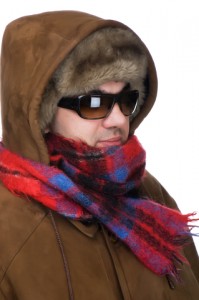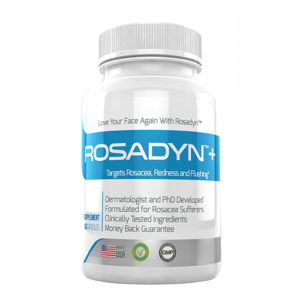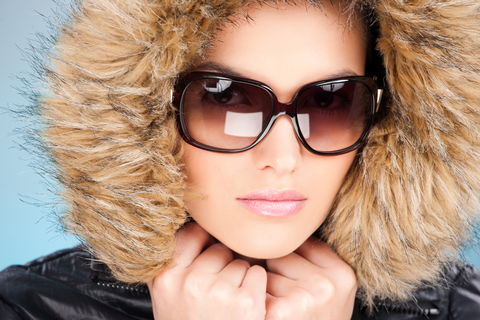 Does winter weather wreak havoc with your rosacea skin? Does harsh outdoor weather followed by overly warm indoor temperatures cause severe dryness, flushing or hyper-reactive skin?
Does winter weather wreak havoc with your rosacea skin? Does harsh outdoor weather followed by overly warm indoor temperatures cause severe dryness, flushing or hyper-reactive skin?
Winter and its associated environmental triggers are the third most common rosacea triggers according to the National Rosacea Society. Winter can be brutal on rosacea skin and force moderate-to-severe rosacea sufferers to experience more breakouts, flare ups, burning sensations let alone the emotional toll it takes on how rosacea sufferers feel when they have to head out and face the world.
Due to the increase in skin cancer and other sun-induced issues many people today understand that protecting their faces by using sunscreens, wearing hats and limiting exposure from direct UV damage is important. But for those diagnosed with rosacea it is not just UV rays that can affect their skin and eyes but also temperature and external environmental factors that they need protection from in order to minimize and control rosacea flare ups. As summer passes and we fall into winter months, rosacea tends to be the worse time of the year for rosacea sufferers due to low humidity, cold winds, and extreme variations in temperatures. So, just like protecting your skin in the summer, it is just as important to protect your skin in the winter if you want to control and minimize rosacea flare ups.
Practical tips to help you minimize winters effects on your rosacea skin.
Facial skin moisturization, barrier protection, daily repair of fragile skin cells, and thickening the protective epidermal barrier can go a long way towards reducing rosacea flare ups and making winter a season to enjoy.
Suggested rosacea skin care tips and rosacea products:
- Wear A Wind Block: Mufflers, scarfs, wide wind blocking hoods and ski masks made of soft non irritating fabrics and materials are your friend in helping to protect your sensitive rosacea skin ( even for those without rosacea). Winter winds are damaging and harsh assaults for all skin types…this is especially true for rosacea sufferers. Winter air is cold and tends to hold less moisture than warmer air which can strip your skin of much needed lipids from your natural skin barrier. So, cover up.
- Avoid HOT showers, tubs and face washing: We know it’s an inviting opportunity to warm up and shake the chill off but hot water and heat is a strong flush inducing trigger for rosacea sufferers. See our rosacea friendly skin care products for suggestions.
- Do use a room humidifier: Winter air contains less moisture and by cranking up the heat in our homes and cars it drys out the air even further depleting moisture from the environment but also your skin. Adding a humidifier into your environment does a great job helping you to combat the drying effects of the winter season and helps you to improve your skin moisture levels. If you are a rosacea suffer who has a difficult time finding a topical moisturizer or barrier cream that does not agitate your skin, consider adding a room humidifier which can help you tremendously in moisturizing your dry winter skin.
You can also add in a moisturizing spray like La Roche-Posay Thermal Spring Water Spray to gently mist in moisture, cool a flush or just prior to applying moisturizer or barrier cream.
- Barrier Protection Creams : As mentioned previously, winter winds can strip your skin’s natural protective barrier lipids…so help your skins natural defenses with barrier protection cream.
Barrier moisturize and repair that’s friendly for sensitive and rosacea skin
Dermalogica Barrier Repair Cream was formulated for the most reactive skins and is an excellent protector against harsh outdoor elements. A waterless moisturizer smooths on gently to help shield against environmental and internal triggers that cause skin stress, barrier degradation and dehydration superb protection of rosacea sensitive skin and locks in moisture for up to 12 hours. This rosacea product also contains chamomile, oat, ginger root extract and botanical actives that work below the surface to help calm inflammatory triggers that lead to sensitization, while helping to minimize discomfort, burning and itching.[space height=”10″]
- Paula’s Choice RESIST Barrier Repair Cream – RESIST Barrier Repair Moisturizer contains ingredients proven to remodel your skin by building and preserving collagen, firming skin and protecting against moisture loss. The active ingredients in the RESIST Barrier Repair Moisturizer help to make a visible difference in the appearance of redness, fine lines, wrinkles, skin tone, and skin firmness… making it an excellent choice for rosacea sufferers. The addition of skin-identical ceramides, oligo-peptides, and lecithin help rebuild skin damaged by harsh winter weather.
- Use Sunscreen Daily – Winter’s rays are just as damaging during the winter months and even more so if you live in an area with snow which magnifies the suns damaging rays. So rosacea or not, sunscreen should always be a part of your daily routine.
- Watch What You Eat: Simple sugars and carbohydrates stimulate inflammation. This includes in skin too, flushing, redness to break outs can occur for many with rosacea after consuming high sugar treats to and carb intense meals. Somtimes this can occur within hours or the next day. So eatting healthy and moderation can go a long way in keeping a flare up in check.
- Strengthen your skin health and wellness. Your skin’s health, thickness and responses start from inside the body. So paying special attention to your health both physically and emotionally can go a long way in helping you control your rosacea.
How Rosadyn rosacea treatment formula helps rosacea sufferers skin from weather and temperature induced flushing, breakouts, from the inside
 Rosadyn helps thicken the epidermal barrier and reduces skin inflammation.
Rosadyn helps thicken the epidermal barrier and reduces skin inflammation.Rosadyn helps encourage your body to thicken the outer epidermal barrier by triggering growth of new keratin cells. Thick skin is much less reactive to external rosacea triggers like winter weather and protects blood vessels, nerves and immune cells. Rosadyn stimulates epidermal growth and reduces epidermal inflammation via three primary ingredients: Mediterranean Olive Fruit Extract, Pine Bark Extract and Sulforaphane. Every cell layer that grows back adds tremendous protection to underlying blood vessels and fragile skin.
Rosadyn’s Mediterranean Olive Fruit Extract Repairs the Rosacea Epidermis
Mediterranean skin is known for its health, beauty and thickness. Part of this is genetic, but recent studies have shown that a diet high in Mediterranean Olive Fruit Extract stimulates healthy skin cell production, supplies the proper precursors for tight, non-porous epidermal cells and protects the facial skin from environmental insults.
Pharmaceutical companies that specialize in developing pharmaceutical-grade nutraceuticals (e.g. medicinal supplements) have isolated two of the primary components in Mediterranean Olive Fruit Extract, Oleuropein (15%) and Verbascoside (5%) as well as important precursors that stimulate epidermal cell division and production. This extract is special because these active ingredients have a great affinity for epidermal cells and keratin, making this one supplement an important and effective part of rosacea treatment. Oral supplementation with clinical doses of Pharmaceutical Grade Olive Fruit extract can double the thickness of the epidermis, strengthen the keratin layers and increase the lipid “glue” that holds all the cells together. This is supported by reports by Rosadyn clients that their skin looks and feels healthier, and is less reactive to wind, cold air, freezing temperatures and snow. In laboratory and clinical studies this unique Nutraceutical has been shows to stimulate the production of:
(1) Keratin Growth Factors (KGF) – the major building blocks of the epidermis
(2) Fibroblast Growth Factors (FGF) – the supporting tissue for the epidermis
(3) Silica (Silicon Precursors) – an important trace element for the epidermis. It helps bind protein molecules together in the epidermis (ie the mortar). Silica produces collagen, an important constituent of healthy epidermal cells and acts as glue in between each layer of the epidermis.
Rosadyn’s Pine Bark Extract Stimulates Epidermal Growth and Thickens the Epidermis
We choose to incorporate a new form of Pine Bark Extract into Rosadyn because it has the highest amount of active peptide fragments called Oligo- meric Proanthodyns (OPC’s) from the Eastern White Pine Bark. This is a Pharmaceutical Grade Extract with an amazing 95% OPC content (compared to 40% for most other Extracts). Pine Bark OPC’s are unique because they have a special affinity for keratin, especially in the epider- mal layer and are guided towards areas of inflammation and dysfunction. At clinical doses, Pine Bark OPC’s can dramatically increase the growth of thin epidermal barriers and also cement them together for added barrier protection to strong environmental insults such as winter triggers. The two main actions of Eastern White Pine Bark OPC’s is to stimulate:
(1) Epidermal Growth Factor (EGF) – just as it sounds, this is the most important molecule involved in increasing the thickness and health of the outer epidermis. The OPC’s bind to the first three layers of the Epidermis where all the cell division takes place and increases energy production (ATP) … which results in increased growth of epidermal cell layers.
(2) Glyco-proteins – these are strong hair-like strands that weave their way through all layers of the epidermis to hold the cells together in a tight mesh formation for better functioning and protection.
Rosadyn’s Sulforaphane Extract Normalizes Epidermal Function by Clearing Epidermal Inflammation
Dr. Talalay directs the Laboratory for Molecular Pharmacology at Johns Hopkins School of Medicine, which discovered the health-promoting properties of sulforaphane, the chemical extract abundant in the Brassica family of vegetables such as Broccoli Sprouts. Broccoli, and cabbage. The lab’s findings were splashed on the front page of The New York Times and hailed as one of the top 100 scientific discoveries of the 20th century by Popular Mechanics. Over the last four years Sulforaphane has been shown to have the strongest anti-inflammatory actions in skin disorders of any Nutraceutical tested to date in the laboratory and human clinical studies. This is one of the most exciting ingredients for Rosadyn as it targets and treats four of the strongest rosacea inflammatory triggers:
(1) Inflammatory Cytokines
(2) Inflammatory Neutrophils
(3) Tumor Necrosis Factor
(4) NF-Kappa-Beta – the Master Inflammatory Switch in skin that is central to rosacea inflammation.By blocking the production of these inflammatory substances, a stronger, thicker, healthier epidermal barrier will replace the rosacea-inflamed epidermis caused by winter and weather/temperature related insults.
Rosacea is not just triggered by external factors but internal vascular health and responses to everyday stresses as well.” Visit our How rosadyn ingredients work for more info
Protect Your Eyes – Winter weather effects Ocular Rosacea too.
Do you know that roughly 20% of people with rosacea showed ocular symptoms first and that roughly 50% of rosacea sufferers have had some ocular involvement?
Just like your skin, your eyes need protection from harsh winter winds and damaging UV rays. This is especially true for rosacea sufferers who have ocular rosacea.
- Wear full spectrum UV protection eye wear : Many sports type glasses wrap around to also help block sun from sides. So not only can this style help block sun rays from the side but also help extend some protection from wind and flying particles from agitating your eyes.
- Moisturize dry eyes: there are many over the counter “eye moisturizers, lubricants and tearing agents” that can help with dry and itchy eyes. (ask your ophthalmologist or dermatologist which they feel is right for you)
- Follow all the other “Practical tips to help you minimize winters effects on your rosacea skin” from this article.
Additional winter tips to help avoid rosacea flare ups
- Layer clothing to maintain a more consistent body temperature. Going from one extreme temperature to another causes a vascular reaction within your body to try to maintain its temperature which is an average 98.6°F (37°C). Rosacea sufferers want to avoid these reactions which is like flipping the rosacea switch on. Wear loose fitting comfortable clothing that can easily help you adapt to temperatures simply by putting on or taking off
- Turn down the heat: In your car and in your home forced air heat, fireplaces/stoves can trigger flair ups so keep the temperature at levels that don’t trigger flare ups for you. Avoid hot air blowing directly on your face or exposed skin which can induce redness and flare ups.
- Not so Hot chocolate: While tempting avoid consuming hot beverages and foods to warm up. For many roscrans, hot beverages and foods are a big trigger for rosacea flair ups. If you happen to be one of the lucky ones whom hot foods and beverages don’t trigger a fair up, you may find that in the winter they do because of the cold to hot temperature fluctuations which cause a vascular response in your body triggering a rosacea flair up.
We hope this article on “How to help protect and treat rosacea skin in the winter” helps you get out and enjoy all that the winter season has to offer without the stress and worry of a reaction from your rosacea. While there is no cure for rosacea, knowing how to manage and minimize its effects and breakouts will put you back in the drivers seat of your life vs. rosacea holding you back from facing the new day with anticipation and joy.


